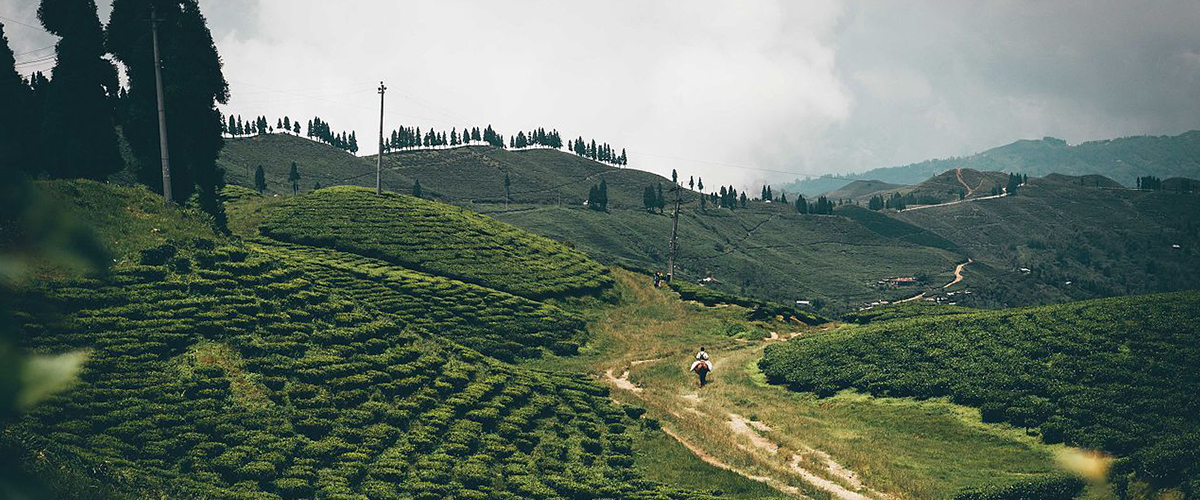Nepal is probably not on your list of teas to buy but it should be. It offers some of the best bargains on the market: teas of growing quality at an excellent price. Guaranse and Ilam have become premium names, with other first rate teas from Antu Valley, Kanyam, and other regions. Many of these cost less per cup than a branded tea bag.
One of the most distinctive features of the Nepal tea industry is that it is almost entirely comprised of smallholders, with the average size of a farm less than acre. Whereas the adjoining Darjeeling estates almost all have their own processing factory, Nepal’s production centers on regional factories buying in leaf. This is giving them many cost advantages (and smuggling opportunities over the Darjeeling producers but also a flexibility and adaptability that enables plenty of innovation.
Nepal black tea is very good indeed. It is not quite the same in taste as Darjeeling, though many experts claim that except for the very best and most expensive Darjeelings, Nepal is offering an attractive and less expensive complement that is typically slightly softer and a little woodier.
Just within the past five years it has been producing superior green teas that are more Japanese in style than the traditional Chinese. If anything, they are ahead of the more established Darjeeling producers. Japanese greens have an extra zip and very clean taste that is more appealing that the somewhat more bitter and watery greens of China.
Guranse estate is the center of the development of the new Nepali tea industry and is in the forefront of techniques. All the tea that it produces is organic. The bushes are grown from clones, not seeds. It is experimenting with varietals from young Darjeeling mother bushes that are robust, disease resistant and flavorful.
In the lowlands, where most of the production is cheap CTC, plants are ready for harvesting in 3-5 years, but the Guranse high hill ones take around seven years before they are mature enough for plucking. Compost and manure are essential for organic farming, making cows a vital resource, but one that villagers can rarely afford. This is why the Himalayan Orthodox Tea Production Association established its Cow Bank to purchase cows that it donates to farmers.
Guranse has modern facilities. It also serves as a processing center for small farms. Over seventy of them formed a cooperative, so that they can sell their product in larger quantities.
Tea is not native to Nepal and appears to have been introduced in the 1860s with the launch of a few estates, one of which, Ilam, remains an elite producer. Until fairly recently, the teas were made for domestic consumption. Up to the 1950s, there were no roads into the region.
The logistics of tea transportation obviously impeded the growth of an export market, but ingenuity and money created a thriving smuggling business that continues to flourish. Teas from Nepal were brought into the adjoining Indian territory and sold as Darjeeling. Legitimate export was complex, with the teas being sent to Calcutta for auction by Indian brokers. Now, there are brokers operating in Nepal who can ensure more visibility and better prices. But Nepal still lacks a strong reputation in the world market. The Indian government imposed a 20% luxury tax on the import of foreign tea, which added to the cost of auctioning it through Calcutta.
The Nepal industry focused on producing a fancy looking leaf rather than a flavorful one. That was because many of the tea plants in Darjeeling had grown old, the leaves lacked the attractive and bright appearance of the best Darjeelings, and were brittle. Nepalese leaf was close in taste and supplemented the Darjeeling—and preserved its profitability through blending in the lower cost Nepal tea.
As in China, the tea farms were government-owned and run by privileged insiders, often amateurs or well-connected ex-tea traders living off the guaranteed monopoly sales. When they were sold off to private owners in the 1990s, entrepreneurs realized that the industry was missing an opportunity. Its terrain and growing conditions are very similar to those of Darjeeling, and its black teas, grown at elevations of 7,000 feet, hold up well in the comparison; as with Darjeelings, there are the first flush, second flush and autumnal harvests. The flavor is a little less sharp than that of the best Darjeelings, but that is not necessarily a disadvantage.
Meanwhile, tea growing continues in Guranse and other areas of Nepal. The Nepal Tree Crop Global Development Alliance and international funding agencies, including USAID, the Dutch government and the OPEC Fund, have invested substantial money to work with the Nepalese government and private sector organizations to stimulate organic tea farming.
A Code of Conduct was signed by 15 orthodox tea producers and estates, focused on biodynamic farming and reduction of pesticide use, banning of child labor, equal opportunity protection, and improvement of working conditions for the women who constitute 80% of the tea pluckers.
The three-year Nepali Smallholder Irrigation Initiative was designed to help 27,000 smallholding families (200,000 people) increase their income by 50%. Its success is indicated by the fact that in its very first year, the 16,000 families it aided did indeed grow their income by half-to the princely sum of $400 a year.
Nepal is the size of Iowa. It is the location of the fabled fictional Shangri La. It is of course noted for its Buddhist history and legendary city of Kathmandu. In tea circles, its growing reputation is adding to its mystique.
Darjeeling has long been a peak of the tea craft. Now, Himalayan tea expands your range of choices. While Nepali prices are increasingly rapidly, driven by new export demand, there are still plenty of bargains in Artisan teas. Why pay more for a supermarket English Breakfast when you can get a Kanyam or Antu Valley for the same price?
Featured banner shows the Kanyam tea estate in Nepal

